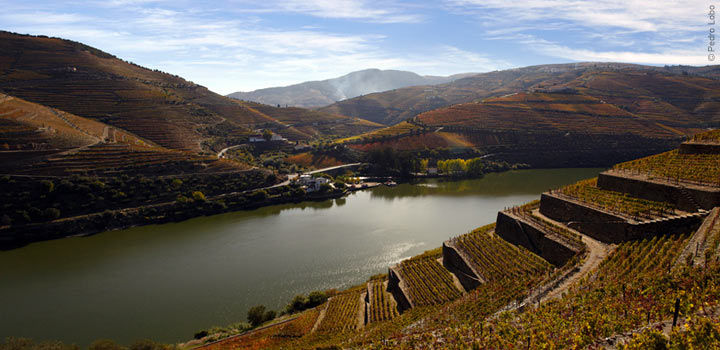
If the British weren’t feuding with the French in the 17th century, we might not have Port wine. It happened this way…during one of their innumerable wars with France, the British imposed a punitive tariff on French wine. This prompted British wine merchants to turn to Portugal, where they found some decent dry red wines in Portugal’s Duoro region. To preserve it during shipment, they added brandy to the fermented wine.
- When a Cistercian monk jumped the gun and added brandy prior to fermentation, the result was a sweet, high alcohol wine – modern day Port. (The high alcohol brandy stops the fermentation before all of the grape sugar is converted to alcohol, thus the sweetness).
- The Brits went all in on Port. Their wine merchants controlled the Port trade, and no proper gentleman could be found without an ample supply to drink with his cronies. In fact, the nobility traditionally gave a “pipe” of Port (about 61 cases) to each of their male children. By the time the child was old enough to drink legally, the wine had matured; hopefully the child had as well.
Port can only be made in a specifically delineated area in Portugal’s Duoro Valley, pictured above. It’s typically red and about 20 percent alcohol, although there are some white Ports. Port is made from grapes that are relatively unknown outside of Portugal; if you want more details, look here.
- Making Port apparently is as much fun as drinking it. Traditionally, the field hands tossed the grapes in concrete troughs called lagars, jumped in and stomped the grapes. As the evening wore on, the music began, corks were pulled, and the ladies jumped in and danced with the men. It seems that the human foot is highly efficient at crushing grapes. Ah, but progress intervened and brought us mechanical replicas of human feet to stomp the grapes; they’re even heated to body temperature. You can’t make this stuff up.
Port comes in many styles; the most popular are:
- Tawny Port. There are several tawny styles, and the richest, most complex are those labeled with an indication of age, such as 10-, 20-, or 30-year-old. These wines are actually made from a blend of several harvests, and thus the age is approximate. These have notes of toasted nuts, brown sugar, and vanilla, and pair well with almond or walnut cakes or crème brûlée. One of our favorites is the Taylor-Fladgate 20 year old ($45 retail). There’s also basic tawny, aged for just a few years, and “Reserve Tawny” which is aged in oak for at least seven years before bottling.
- Reserve Port. These are relatively inexpensive, good quality wines that typically age four to six years in barrels, and feature bold berry flavors. Two of the most popular are Graham’s Six Grapes and Sandeman’s Founder’s Reserve (both $20 retail).
- Late Bottled Vintage. These are moderately priced wines made from a single vintage and matured in oak vats for four to six years before. This style is typically served in good restaurants, and pairs well with chocolate. These also run around $20 retail.
- Vintage. The most expensive Port, it’s only made in exceptional years from the highest quality grapes and will have the vintage year on the label. Aged two years in barrel, then aged in bottle for at least a decade. It’s a dessert all by itself, but pairs well with blue cheese or chocolate. Vintage Port runs from around $100 to well over $200 per bottle.
Our wine of the week is Sandeman Founders Reserve Porto ($20 retail). We selected this wine because it’s a relatively inexpensive but good quality Port. This is a very pleasant ruby colored wine with aromas of cherry, strawberry and caramel. On the palate, it's sweet, with red fruit, chocolate and butter cream. It should be served at about 60 degrees. If you prefer a more robust, complex wine with less prominent fruit, try the Taylor-Fladgate 10-year ($28) or 20-year tawny.
Pairing and serving notes. Port is typically served in a slightly smaller than normal pour, about two to three ounces. Any good sized wine glass will do. Once opened, a bottle of aged tawny will last one to six months; late bottled vintage around one week to one month, and vintage Port from one day (very old wines) to one week. Vintage and late-bottled vintage will have sediment and should be decanted.
Cheers!

I look forward to the well balanced cellar article. Wouod that balance include wines that are paired as well as those that are just great for drinking I struggle with wines that are great with food but not so much able to stand on their own.
An interesting point. Many, but certainly not all, wines that are built for aging are best with food. So, we’ll pick up on that point.
Jim we really appreciate your blog
It puts wine into layman’s terms and the background information is always very interesting
Would you ever consider advising on a well balanced cellar
I know your first response will be it depends on our individual tastes but I think it would be good to have a list of all the wines you would have in a well rounded cellar
Bruce,
Yes, I think the idea of a well-balanced cellar post is a good one, and something I’ll address after the holidays. For the next few weeks, I’m concentrating on depleting my cellar!